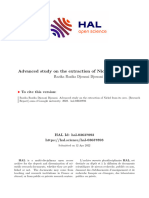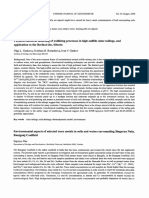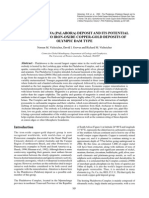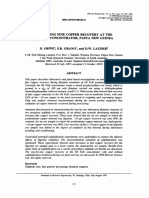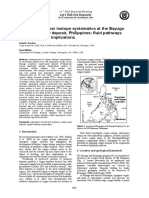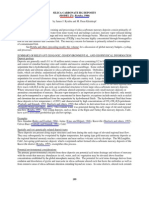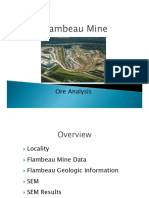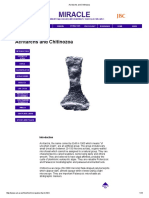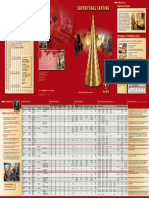Geochemistry in The Exploration of Nickeliferous Laterite Pablito M. Ong and Arturo C. Sevillano A. Soriano Corporation, Makati, Rizal (Philippines)
Geochemistry in The Exploration of Nickeliferous Laterite Pablito M. Ong and Arturo C. Sevillano A. Soriano Corporation, Makati, Rizal (Philippines)
Uploaded by
Belle Estal PalajosCopyright:
Available Formats
Geochemistry in The Exploration of Nickeliferous Laterite Pablito M. Ong and Arturo C. Sevillano A. Soriano Corporation, Makati, Rizal (Philippines)
Geochemistry in The Exploration of Nickeliferous Laterite Pablito M. Ong and Arturo C. Sevillano A. Soriano Corporation, Makati, Rizal (Philippines)
Uploaded by
Belle Estal PalajosOriginal Description:
Original Title
Copyright
Available Formats
Share this document
Did you find this document useful?
Is this content inappropriate?
Copyright:
Available Formats
Geochemistry in The Exploration of Nickeliferous Laterite Pablito M. Ong and Arturo C. Sevillano A. Soriano Corporation, Makati, Rizal (Philippines)
Geochemistry in The Exploration of Nickeliferous Laterite Pablito M. Ong and Arturo C. Sevillano A. Soriano Corporation, Makati, Rizal (Philippines)
Uploaded by
Belle Estal PalajosCopyright:
Available Formats
Geochemistry in the Exploration of Nickeliferous Laterite
PABLITO M. ONG and ARTURO C. SEVILLANO
A. Soriano Corporation, Makati, Rizal (Philippines)
Abstract
Applied geochemistry was used in prospecting and in the preliminary exploration of four
nickeliferous laterite deposits in Palawan, Philippines.
Near-surface soils were collected from a grid with a 300-m square sampling pattern. Based on
the evaluation of geochemical results from the soil samples, each laterite prospect was
subdivided into "geochemical areas", namely: (a) highly anomalous, (b) anomalous, (c) slightly
anomalous, and (d) background areas.
At Long Point, Palawan, the first laterite prospect, the geochemical areas were probed by test
pitting. The majority of test pits in the slightly anomalous to highly anomalous areas, particularly
in the latter, penetrated possible nickel ore (>0.9% Ni) in laterite and/or in the subjacent
decomposed ultramafic rocks. By contrast, most of the test pits sunk to check the background
areas encountered nickel deposits which are below the cut-off grade.
Using the resulting geochemical anomaly maps as guides in the exploration of other laterite
prospects, test pitting was largely confined to the slightly to highly anomalous portions of the
nickeliferous laterite prospects. Sinking of unnecessary test pits in areas containing low-grade
nickel was thus avoided resulting in substantial savings in exploration costs.
Geostatistical and Mineralogical Insights on Some Nickel Prospects in the
Philippines
Carlo Arcilla
Director
National Institute of Geological Science
Cherisse R. Ferrer, Engielle Mae R. Paguican, Meryl Y. Calibo, Mark John S. Africa, Zaymon
Calucin, Justin Vidamo and Mary Jane B. Moral
National Institute of Geological Science
University of the Philippines
With the prices of Nickel in historical highs, deposits with close to 1% Ni content are now viable
mining targets. Since the Philippines is host to several ophiolite deposits with ultramafic
sections exposed, large areas with these rocks as bedrocks and exposed to rain-induced chemical
weathering can be exploration targets. We examine some marginal deposits that have been
sampled extensively, and try to delineate the mineralogical residence of Ni and Cr, using
polarized and transmitted light microscopy, combined X-Ray Diffraction, X-Ray Fluorescence
and Atomic Absorption Spectrophotometer methods. The mineralogical residence of Nickel is
important not only for extraction but also for the mode of chemical analysis used in determining
concentrations. For example, iron oxide and hydroxide-dominated laterites can easily be
dissolved by three acid digestive process prior to quantitative chemical analysis; however,
saprolite and garnierite-rich portions of the Nickel deposit contain nickel-bearing silicates that
can only be dissolved completely with hydrofluoric acid. The implication is that Nickel values
could be underestimated in saprolitic and garnieritic zones if the chemical analysis does not
involve HF. Important geostatistical relationships between Ni, Cr, and Fe are also important tools
in delineating areas which are probable ore horizons. We have documented that a "chromitebased" approach to nickel exploration could miss out nickel orebodies because the denser
chromitites do not host substantial amounts of nickel. These observations have profound
implications for exploration and chemical analysis of nickel laterite and saprolite ores.
Geochemistry and mineralogy of Philippine Nickel laterite deposits
CARLO A. ARCILLA, RUSSEL ONG, MERYL CALIBO AND CHERISSE FERRER (2013)
National Institute of Geological Sciences, University of the Philippines, Quezon City,
Philippines,
(caloy.arcilla@gmail.com)
Increased worldwide demand for steel has led into exploitation of nickel coming from Nickelenriched soils weathered from ultramafic ophiolites. The Philippines is the second largest
producer of nickel laterites which are mostly fed into blast furnaces in China. We have
conducted extensive mineralogical and geochemical studies on these laterites comprising: 1)
XRD and Rietveld refinement to identify mineralogical phases of laterites, 2) sequential
extraction studies to delineate phases wherein nickel is enriched preferentially and 3) major and
trace element analyses of laterite stratigraphy. We find that iron oxides and hydroxides dominate
the limonite phase, not clay minerals, the latter only occurring in the lower saprolite phases
which are dominated by serpentine-type minerals. While olivine precursors dominate the
peridotite bedrock of laterites, we notice that pyroxene-rich horizons give rise to higher-grade
nickel laterites. Trace element analyses also reveal surprisingly enriched concentrations of some
rare-earth elements and other elements (e.g, Sc, Ti,V) that are not included in payment credits for
the ores.
Reactive transport geochemical modelling of a Philippine iron-nickel laterite
KARMINA AQUINO EMMANUEL CODILLO AND CARLO ARCILLA (2015)
National Institute of Geological Sciences, University of the Philippines,
{karminaaquino@gmail.com, emmanuelcodillo@gmail.com * caloy.arcilla@gmail.com
The Philippines is one of the worlds largest sources of nickel from laterites. Ultramafic rocks in
tropical areas typically comprise heavily serpentinized peridotites and pyroxenites overlain by Nirich laterites. How the topmost iron-rich laterite and the relatively Ni-rich saprolite intermediate
horizon develops with time is modelled using reactive transport module in Geochemists
WorkBench. A hypothetical 5m-thick lherzolite with predefined properties (i.e. porosity,
dispersivity) was reacted with a) ultramafic draining river water and b) hyperalkaline groundwater
in a trial span of 130 years. Chrysotile, talc, clinochlore, hematite, goethite, magnetite, tremolite
and quartz were allowed to precipitate in the system. The modeling broadly replicates the typical
zonation within a laterite profile consisting of an uppermost limonite layer rich in Fe-hydroxides
and oxyhydroxides and a middle saprolite layer rich in hydrated Mg silicates represented here by
talc. The temporal downward migration of talc results in the thickening of the limonite layer and
the enrichment of Nickel in garnierites. Serpentine and chlorite remained undersaturated, implying
that the abundance of these minerals is not due to weathering but probably to emplacement history.
Occurrences of nickel in different host phases of a laterite deposit: An example from
Berong, Philippines
M.Y. CALIBO*, C.A. ARCILLA, R.M. ONG, M.L.G. TEJADA AND J.P. RAFOLS National
Institute of Geological Sciences, University of the Philippines Diliman, Quezon City, 1101
Philippines (*correspondence: merylyc@gmail.com)
Despite being globally widespread and relatively easy to mine, nickel laterite ores prove to be
difficult to process. Beneficiation of Ni and other economically extractable elements along with it,
greatly depends on the mixture of the feed material (silicate phases and oxide phases) which, in
turn, is dependent on the mineralogy of the raw ore. The type(s), concentration and consumption
of acid to be used in dissolution are controlled by the percentages of both gangue and host minerals
trapping the Ni, whether by sorption or isomorphous substitution. A modified selective sequential
extraction was designed to recover Ni from from its various host phases to optimize the
beneficiation process using samples from different zones in a nickel laterite deposit in Berong,
Palawan. This deposit is defined by, from top to bottom, an iron oxide-hydroxide zone, a transition
zone made up of serpentine and iron oxides, a nickel-enriched serpentine zone, and a nickeldepleted serpentine zone, based on mineralogy and geochemistry. The occurrence of Ni as
adsorbed and exchangeable cations, in carbonates, in amorphous iron oxides, within the structure
of crystalline iron oxides and hydroxides, and in residual silicate layers within each of the zones
was determined. Qualitative analysis of nickel in iron oxides, serpentine and talc using electronprobe microanalyzer supports the results of the extraction experiment. In limonite zones,
dominated by goethite and other secondary iron oxides, > 90% of the total nickel reside in the
crystal structure of Fe oxides. In the iron oxide magnesium silicate transition horizon and in the
nickel-enriched saprolite zone, respectively, > 80% and an average of 77% of the nickel are
distributed in Fe oxides and within the octahedral layers of serpentine. The remaining Ni ions not
taken up by these crystalline minerals are mostly associated with amorphous Fe oxides. An EPMA
image, depicting relative abundance of Ni, Mg, and Fe in a section of weathered bedrock, implies
that Ni is more closely associated with Fe than with Mg. An industrially significant output of this
research is the finding that residual silicates, which take an enormous amount of acid to dissolve,
need not be dissolved in order to optimize the beneficiation of nickel.
Trace elements (REE, Sc, Y) in laterites from Mindoro, Philippines
CARMELA TUPAZ AND CARLO ARCILLA
National Institute of Geological Sciences, University of the Philippines,
(carmelaalen.tupaz@gmail.com, *caloy.arcilla@gmail.com)
The Philippines is one of the worlds largest nickel sources from its weathered ultramafic laterites.
Aside from Ni (% occurrence), other trace elements were only recently analyzed (REE, Sc, Y) that
are not included in ore payments. Some Mindoro laterites were examined by several sample
preparation methodologies and ICPMS. The data show a strong correlation of Sc (8-68 ppm) with
high Fe occurrence in laterites, also observed elsewhere. Laterite samples also show relative
depletion of heavy rare earth elements (HREE) Dy to Lu, to light rare earth elements (LREE),
but whether this is source related or weathering induced is not definitive. The significance for
Philippine economic geology is that the low-grade, unmined iron-rich but nickel-poor laterites may
actually host significant Sc that could add to the economic viability of these ores.
You might also like
- Evolution of A Forearc Basin, Luzon Central Valley, PhilippinesNo ratings yetEvolution of A Forearc Basin, Luzon Central Valley, Philippines1 page
- Weda-Bay-Journal-of-Geochemical(Geology)-2019100% (1)Weda-Bay-Journal-of-Geochemical(Geology)-201912 pages
- Program Pascasarjana Teknik Geologi UPN "Veteran" YogyakartaNo ratings yetProgram Pascasarjana Teknik Geologi UPN "Veteran" Yogyakarta15 pages
- The Phalaborwa Complex Is Palaeoproterozoic in Age0% (1)The Phalaborwa Complex Is Palaeoproterozoic in Age12 pages
- Geology and exploration indications of the lithocap in Qianpu area, LuzongNo ratings yetGeology and exploration indications of the lithocap in Qianpu area, Luzong14 pages
- A Review Study On The Extraction of Nickel From Its OresNo ratings yetA Review Study On The Extraction of Nickel From Its Ores44 pages
- Relationship Between Process Mineralogical Characterization and Beneficiability of Low-Grade Laterite Nickel OreNo ratings yetRelationship Between Process Mineralogical Characterization and Beneficiability of Low-Grade Laterite Nickel Ore13 pages
- Efficient Extraction of Copper and Zinc From Seafloor Massive Sulphide Rock Samples From The Loki's Castle Area at The Arctic Mid-Ocean RidgeNo ratings yetEfficient Extraction of Copper and Zinc From Seafloor Massive Sulphide Rock Samples From The Loki's Castle Area at The Arctic Mid-Ocean Ridge11 pages
- Pizarro et al., 2023. Use of porphyry indicator zircons in the sedimentary record as an exploration tool for covered porphyry copper deposits in the Atacama Desert, ChileNo ratings yetPizarro et al., 2023. Use of porphyry indicator zircons in the sedimentary record as an exploration tool for covered porphyry copper deposits in the Atacama Desert, Chile17 pages
- Chamberlain 2007. Toward An Integrated Model For Alkalic Porphyry Copper Deposits PDFNo ratings yetChamberlain 2007. Toward An Integrated Model For Alkalic Porphyry Copper Deposits PDF16 pages
- Nickel in Buli Coastal Area, East HalmaheraNo ratings yetNickel in Buli Coastal Area, East Halmahera12 pages
- Increasing Fine Copper Recovery at The Ok Tedi Concentrator, Papua New GuineaNo ratings yetIncreasing Fine Copper Recovery at The Ok Tedi Concentrator, Papua New Guinea17 pages
- Supergene Copper Isotope Systematics at The Bayugo Cu-Au Porphyry Deposit, Philippines: Fluid Pathways and Exploration ImplicationsNo ratings yetSupergene Copper Isotope Systematics at The Bayugo Cu-Au Porphyry Deposit, Philippines: Fluid Pathways and Exploration Implications3 pages
- Geotechnical Properties of Nickel Laterite Heap Leached Ore Ripios and Plant ResidueNo ratings yetGeotechnical Properties of Nickel Laterite Heap Leached Ore Ripios and Plant Residue14 pages
- Characterization of Weda Bay Nickel Laterite Ore From IndonesiaNo ratings yetCharacterization of Weda Bay Nickel Laterite Ore From Indonesia29 pages
- A Geological Review of The Tampakan Copper-Gold Deposit, Southern Mindanao, Philippines100% (1)A Geological Review of The Tampakan Copper-Gold Deposit, Southern Mindanao, Philippines16 pages
- Regolith Domain Modelling Using Multivariate Cluster Analysis at MT Thirsty Co-Ni DepositNo ratings yetRegolith Domain Modelling Using Multivariate Cluster Analysis at MT Thirsty Co-Ni Deposit9 pages
- Geochemistry and Origin of The Oligocene Binkılıç Manganese Deposit Thrace Basin, TurkeyNo ratings yetGeochemistry and Origin of The Oligocene Binkılıç Manganese Deposit Thrace Basin, Turkey13 pages
- Selective Flotation of Enargite From Copper Sulphides in Tampakan DepositNo ratings yetSelective Flotation of Enargite From Copper Sulphides in Tampakan Deposit10 pages
- Geology and Exploration of Porphyry Copper Deposits: in North Sulawesi, IndonesiaNo ratings yetGeology and Exploration of Porphyry Copper Deposits: in North Sulawesi, Indonesia17 pages
- Silica-Carbonate HG Deposits (MODEL 27c Rytuba, 1986)No ratings yetSilica-Carbonate HG Deposits (MODEL 27c Rytuba, 1986)5 pages
- Nickel Laterite Classification and Features by Brand Et Al.100% (1)Nickel Laterite Classification and Features by Brand Et Al.8 pages
- Sources of Sulphur in the Katanga CopperNo ratings yetSources of Sulphur in the Katanga Copper6 pages
- Geochemical Records of The Ovalibağ Quaternary Sediments, Ciftlik Plain, Central TurkeyNo ratings yetGeochemical Records of The Ovalibağ Quaternary Sediments, Ciftlik Plain, Central Turkey10 pages
- BlenkinsopKadzviti2006 - Fluid Flow in Shear Zones Insights From The Geometry and Evolution of Ore Bodies at Renco Gold Mine, ZimbabweNo ratings yetBlenkinsopKadzviti2006 - Fluid Flow in Shear Zones Insights From The Geometry and Evolution of Ore Bodies at Renco Gold Mine, Zimbabwe13 pages
- Mining Industry Statistics: $2,840 Million $2,337 Million $3,412 Million $4,013 Million $2,290 MillionNo ratings yetMining Industry Statistics: $2,840 Million $2,337 Million $3,412 Million $4,013 Million $2,290 Million1 page
- Mineral Unit Closing Price Source As of April 08, 2016: Average)No ratings yetMineral Unit Closing Price Source As of April 08, 2016: Average)1 page
- Palynomorphs: Casenas, Matthew Ray T. de Leon, Faye Ann100% (1)Palynomorphs: Casenas, Matthew Ray T. de Leon, Faye Ann14 pages
- Lagerstätten: Prepared By: SABINO, Anna Nerissa C. SAN JOSE, Czarina Maye PNo ratings yetLagerstätten: Prepared By: SABINO, Anna Nerissa C. SAN JOSE, Czarina Maye P19 pages
- A Hypothesis For Cast Iron MicrostructuresNo ratings yetA Hypothesis For Cast Iron Microstructures16 pages
- Welding - Recommendations For Welding of Metallic MaterialsNo ratings yetWelding - Recommendations For Welding of Metallic Materials32 pages
- MMG - Schleuderguss - Folder - Eng - Norma de BronzeNo ratings yetMMG - Schleuderguss - Folder - Eng - Norma de Bronze2 pages
- Problem-Solving Model: Identify Determine Root CauseNo ratings yetProblem-Solving Model: Identify Determine Root Cause68 pages
- W1W2 BTD1123 Chapter 1 Intro To Mat ScienceNo ratings yetW1W2 BTD1123 Chapter 1 Intro To Mat Science39 pages
- Esabbasicweldingfillarmetaltechnology 150312185120 Conversion Gate01No ratings yetEsabbasicweldingfillarmetaltechnology 150312185120 Conversion Gate01301 pages
- Application of Dilatometric Analysis To The Study of Solid-Solid Phase Transformations in SteelsNo ratings yetApplication of Dilatometric Analysis To The Study of Solid-Solid Phase Transformations in Steels32 pages
- Machining Operations - (MF F316) - 19, 20No ratings yetMachining Operations - (MF F316) - 19, 2017 pages
- Mineral Deposits and Exploration Potential of NigeriaFrom EverandMineral Deposits and Exploration Potential of Nigeria
- Evolution of A Forearc Basin, Luzon Central Valley, PhilippinesEvolution of A Forearc Basin, Luzon Central Valley, Philippines
- Program Pascasarjana Teknik Geologi UPN "Veteran" YogyakartaProgram Pascasarjana Teknik Geologi UPN "Veteran" Yogyakarta
- The Phalaborwa Complex Is Palaeoproterozoic in AgeThe Phalaborwa Complex Is Palaeoproterozoic in Age
- Geology and exploration indications of the lithocap in Qianpu area, LuzongGeology and exploration indications of the lithocap in Qianpu area, Luzong
- A Review Study On The Extraction of Nickel From Its OresA Review Study On The Extraction of Nickel From Its Ores
- Relationship Between Process Mineralogical Characterization and Beneficiability of Low-Grade Laterite Nickel OreRelationship Between Process Mineralogical Characterization and Beneficiability of Low-Grade Laterite Nickel Ore
- Efficient Extraction of Copper and Zinc From Seafloor Massive Sulphide Rock Samples From The Loki's Castle Area at The Arctic Mid-Ocean RidgeEfficient Extraction of Copper and Zinc From Seafloor Massive Sulphide Rock Samples From The Loki's Castle Area at The Arctic Mid-Ocean Ridge
- Pizarro et al., 2023. Use of porphyry indicator zircons in the sedimentary record as an exploration tool for covered porphyry copper deposits in the Atacama Desert, ChilePizarro et al., 2023. Use of porphyry indicator zircons in the sedimentary record as an exploration tool for covered porphyry copper deposits in the Atacama Desert, Chile
- Chamberlain 2007. Toward An Integrated Model For Alkalic Porphyry Copper Deposits PDFChamberlain 2007. Toward An Integrated Model For Alkalic Porphyry Copper Deposits PDF
- Increasing Fine Copper Recovery at The Ok Tedi Concentrator, Papua New GuineaIncreasing Fine Copper Recovery at The Ok Tedi Concentrator, Papua New Guinea
- Supergene Copper Isotope Systematics at The Bayugo Cu-Au Porphyry Deposit, Philippines: Fluid Pathways and Exploration ImplicationsSupergene Copper Isotope Systematics at The Bayugo Cu-Au Porphyry Deposit, Philippines: Fluid Pathways and Exploration Implications
- Geotechnical Properties of Nickel Laterite Heap Leached Ore Ripios and Plant ResidueGeotechnical Properties of Nickel Laterite Heap Leached Ore Ripios and Plant Residue
- Characterization of Weda Bay Nickel Laterite Ore From IndonesiaCharacterization of Weda Bay Nickel Laterite Ore From Indonesia
- A Geological Review of The Tampakan Copper-Gold Deposit, Southern Mindanao, PhilippinesA Geological Review of The Tampakan Copper-Gold Deposit, Southern Mindanao, Philippines
- Regolith Domain Modelling Using Multivariate Cluster Analysis at MT Thirsty Co-Ni DepositRegolith Domain Modelling Using Multivariate Cluster Analysis at MT Thirsty Co-Ni Deposit
- Geochemistry and Origin of The Oligocene Binkılıç Manganese Deposit Thrace Basin, TurkeyGeochemistry and Origin of The Oligocene Binkılıç Manganese Deposit Thrace Basin, Turkey
- Selective Flotation of Enargite From Copper Sulphides in Tampakan DepositSelective Flotation of Enargite From Copper Sulphides in Tampakan Deposit
- Geology and Exploration of Porphyry Copper Deposits: in North Sulawesi, IndonesiaGeology and Exploration of Porphyry Copper Deposits: in North Sulawesi, Indonesia
- Silica-Carbonate HG Deposits (MODEL 27c Rytuba, 1986)Silica-Carbonate HG Deposits (MODEL 27c Rytuba, 1986)
- Nickel Laterite Classification and Features by Brand Et Al.Nickel Laterite Classification and Features by Brand Et Al.
- Geochemical Records of The Ovalibağ Quaternary Sediments, Ciftlik Plain, Central TurkeyGeochemical Records of The Ovalibağ Quaternary Sediments, Ciftlik Plain, Central Turkey
- BlenkinsopKadzviti2006 - Fluid Flow in Shear Zones Insights From The Geometry and Evolution of Ore Bodies at Renco Gold Mine, ZimbabweBlenkinsopKadzviti2006 - Fluid Flow in Shear Zones Insights From The Geometry and Evolution of Ore Bodies at Renco Gold Mine, Zimbabwe
- Mining Industry Statistics: $2,840 Million $2,337 Million $3,412 Million $4,013 Million $2,290 MillionMining Industry Statistics: $2,840 Million $2,337 Million $3,412 Million $4,013 Million $2,290 Million
- Mineral Unit Closing Price Source As of April 08, 2016: Average)Mineral Unit Closing Price Source As of April 08, 2016: Average)
- Palynomorphs: Casenas, Matthew Ray T. de Leon, Faye AnnPalynomorphs: Casenas, Matthew Ray T. de Leon, Faye Ann
- Lagerstätten: Prepared By: SABINO, Anna Nerissa C. SAN JOSE, Czarina Maye PLagerstätten: Prepared By: SABINO, Anna Nerissa C. SAN JOSE, Czarina Maye P
- Welding - Recommendations For Welding of Metallic MaterialsWelding - Recommendations For Welding of Metallic Materials
- MMG - Schleuderguss - Folder - Eng - Norma de BronzeMMG - Schleuderguss - Folder - Eng - Norma de Bronze
- Problem-Solving Model: Identify Determine Root CauseProblem-Solving Model: Identify Determine Root Cause
- Esabbasicweldingfillarmetaltechnology 150312185120 Conversion Gate01Esabbasicweldingfillarmetaltechnology 150312185120 Conversion Gate01
- Application of Dilatometric Analysis To The Study of Solid-Solid Phase Transformations in SteelsApplication of Dilatometric Analysis To The Study of Solid-Solid Phase Transformations in Steels
















